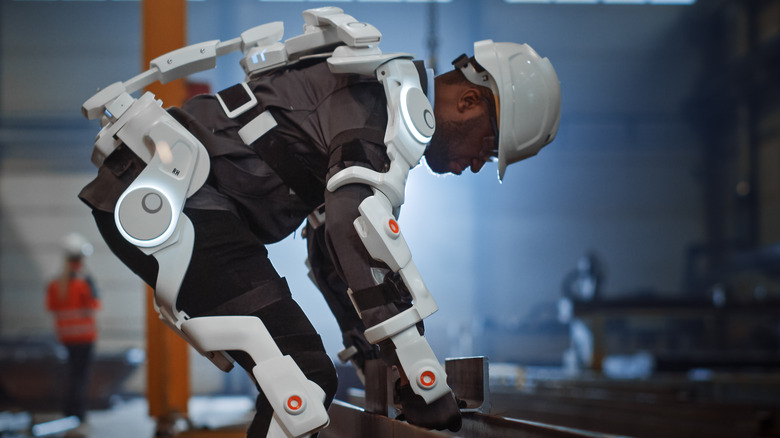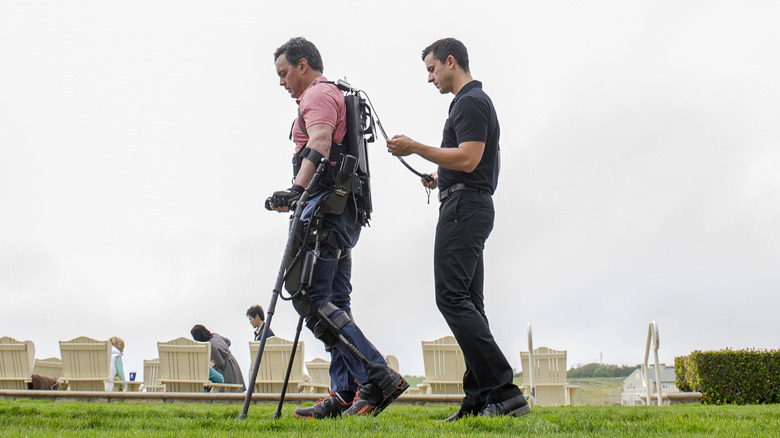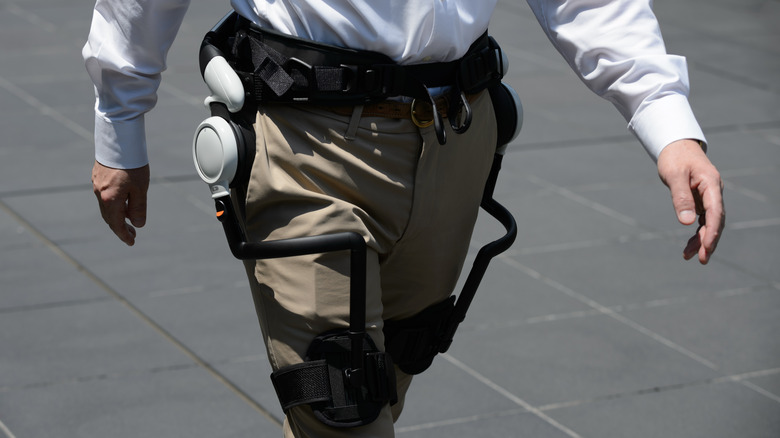The Strange History Of Human Exoskeletons Explained
For sci-fi fans, human exoskeletons are nothing new. Remember the end of the now-classic "Aliens" (1986), where Sigourney Weaver straps into that giant power loader and goes hand-to-hand with the alien queen? That's an exoskeleton (clip on YouTube). More recently, Matt Damon in 2013's "Elysium" features a smaller version of an exoskeleton that attaches to the arms, legs, and back, and basically makes its wearer stronger, faster, and so on.
As it turns out, both kinds of exoskeletons are more or less realities. As Live Science reports, Lockheed Martin and Ekso Bionics have designed one such exoskeleton for military use, dubbed the Human Universal Load Carrier, or HULC. As Army Technology says, it was first developed in 2008 to allow soldiers to carry things as heavy as 91 kg (about 200 lbs) with minimal effort. Now in its third generation, HULC weighs about 24 kg (53 lbs), is adjustable for different heights, and can be taken off and packed up in 30 seconds. It's battery-powered, has an onboard microcomputer that compensates for individual motion, can be equipped with armor, sensors, heating and cooling systems, and more.
The HULC, known as "bionic" technology, is far from the only one of its kind. Northrup Grumman, Able Human Motion, Cyberdyne, and many other companies have all developed their own exoskeletons. But before you go thinking that the next stage of bionic warfare is upon us, bear in mind that many of these suits are designed for medical purposes.
Bionics, cyborgs, and androids
Before we continue, we need to clarify some terms. Exoskeletons are "bionic" because they strap onto people and can be taken off; they're not integrated into the human body. Integrated human-and-machine combos are "cyborgs," like the Borg from "Star Trek." A "robot" may or may not look like a person, but an "android" definitely does. And strictly speaking, an "android" looks male, while a "gynoid" looks female.
As the BBC outlines, bionics are the simplest form of robotic augmentations that can be adapted for human use. They rely on electrical feedback, exactly the way synthetic limbs work. Such prosthetics read neurological signals to determine a person's intended movement, as if they were controlling a biological hand, foot, and so on. Folks like Professor of Media Arts and Sciences Hugh Herr, who has two prosthetic legs and self-describes as "not yet a cyborg," works along with colleagues at Team Cyborg at MIT to advance the field of cybernetics. Like other "transhumanists," he believes that humanity is on its way toward a full-on robotically integrated, if not consciousness-disembodied, future.
Some exoskeletons, like the comparatively cheap "MUSCLE SUIT Every" (yes, that's the real name) use simple pneumatics (compressed air), like the tech built into heavy doors (via Interesting Engineering). It can add about 25.5 kg (56 lbs) of force to a person's lift. Others, like Panasonic's $5,000 "full body garment" Power Loader PLL-01, uses hydraulics (compressed fluid), and can add 100 kg (220 lbs) of force (via Extreme Tech).
Medical, manufacturing, military, and recreational use
While the field of cybernetics is relatively new, its ambitions have been around for decades. As Eduexo says, General Electric developed the first exoskeleton in 1965 to help workers lift heavy objects, while researchers in the 1970s developed the first exoskeleton to help the mobility-impaired to walk. Only now, though, do we have the technology to bring such visions fully to life. The first truly modern exoskeleton came in 2001 from Lokomat, which by 2013 shipped 500 suits for use in hospitals and physical rehabilitation centers.
No matter the purpose, it's likely that cybernetics will be on forefront of technological advancements continuing into the 21st century. Developer Northrup Grumman cites spinal cord injuries and an increasingly elderly human population as their primary drivers. Relatedly, Cigna healthcare in the U.S. shockingly stated in 2019 that they would start considering covering exoskeletons. In manufacturing, exoskeletons could ease the lives of manual laborers and factory workers. And some people, like the aforementioned Professor Hugh Heff, just want to go running all day at 20 mph (per the BBC).
Exoskeletal research is driven by the desire to supersede innate human limitations; that desire won't be going away any time soon. Nevertheless, it's important to think of potential pitfalls as well as obvious benefits. Just imagine corporate overlords demanding more work from those who were previously overburdened without suits. But at least we've already got a decent defense against an alien queen.


